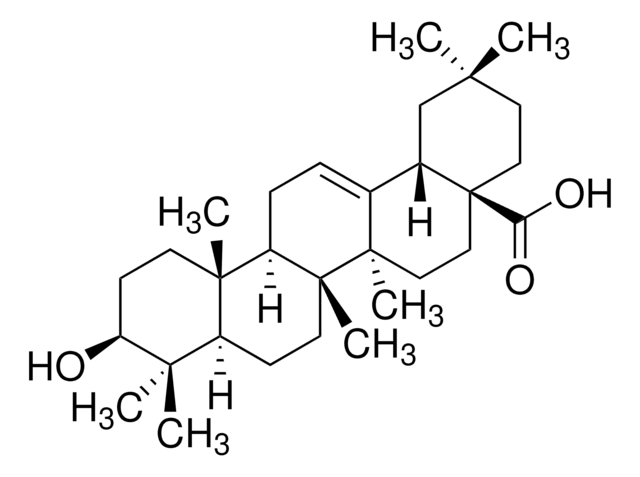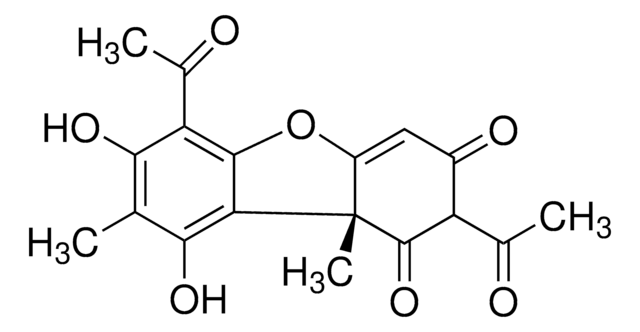SBR00039
Hygromycin B
Min. 95% (HPLC ELSD) Ready Made Solution, 50 mg/mL in water (from Streptomyces hygroscopicus)
Synonym(s):
Hygromycin B solution from Streptomyces hygroscopicus
About This Item
Recommended Products
Product Name
Hygromycin B, Min. 95% (HPLC ELSD) Ready Made Solution, 50 mg/mL in water (from Streptomyces hygroscopicus)
biological source
Streptomyces hygroscopicus
Quality Level
assay
≥95%
form
liquid
concentration
50 mg/mL in water (from Streptomyces hygroscopicus)
antibiotic activity spectrum
Gram-negative bacteria
Gram-positive bacteria
fungi
viruses
mode of action
protein synthesis | interferes
storage temp.
2-8°C
SMILES string
CN[C@H]1C[C@@H](N)[C@H](O)[C@@H](O[C@@H]2O[C@H](CO)[C@H](O)[C@@H]3OC4(O[C@H]([C@H](N)CO)[C@H](O)[C@H](O)[C@H]4O)O[C@H]23)[C@@H]1O
InChI
1S/C20H37N3O13/c1-23-7-2-5(21)9(26)15(10(7)27)33-19-17-16(11(28)8(4-25)32-19)35-20(36-17)18(31)13(30)12(29)14(34-20)6(22)3-24/h5-19,23-31H,2-4,21-22H2,1H3/t5-,6-,7+,8-,9+,10-,11+,12-,13+,14-,15-,16+,17+,18-,19+,20+/m1/s1
InChI key
GRRNUXAQVGOGFE-XKIAHZFYSA-N
Looking for similar products? Visit Product Comparison Guide
General description
Widely utilized for selection and maintenance purposes, Hygromycin B showcases its inhibitory prowess on protein synthesis, contributing to its role in the selection and upkeep of both prokaryotic and eukaryotic cells featuring the hygromycin resistance gene. This antibiotic demonstrates anthelmintic activity in addition to its impact on translational processes in ribosomes across diverse organisms. Its specificity in inhibiting translocation, as well as its influence on decoding fidelity, makes Hygromycin B a valuable tool for the selection of transfected cells containing the Escherichia coli hygromycin resistance gene (hyg or hph) and for maintaining the Hygromycin phenotype in resistant cells. The monophasic inhibition of polypeptide synthesis suggests a single-site binding of Hygromycin B to the ribosome, adding a layer of specificity to its mode of action, making it indispensable for various facets of scientific research in cell biology and biochemical research.
Application
Biochem/physiol Actions
Antimicrobial Spectrum: Hygromycin B acts against bacteria, fungi and higher eukaryotic cells.
Features and Benefits
- High-quality antibiotic suitable for multiple research applications
- Ideal for Cell Biology, Metabolomics, and Biochemical research
- Ready-made solution for ease of use
Other Notes
signalword
Danger
hcodes
Hazard Classifications
Acute Tox. 1 Inhalation - Acute Tox. 3 Oral - Acute Tox. 4 Dermal
Storage Class
6.1B - Non-combustible acute toxic Cat. 1 and 2 / very toxic hazardous materials
wgk_germany
WGK 3
Choose from one of the most recent versions:
Certificates of Analysis (COA)
Don't see the Right Version?
If you require a particular version, you can look up a specific certificate by the Lot or Batch number.
Already Own This Product?
Find documentation for the products that you have recently purchased in the Document Library.
Our team of scientists has experience in all areas of research including Life Science, Material Science, Chemical Synthesis, Chromatography, Analytical and many others.
Contact Technical Service





